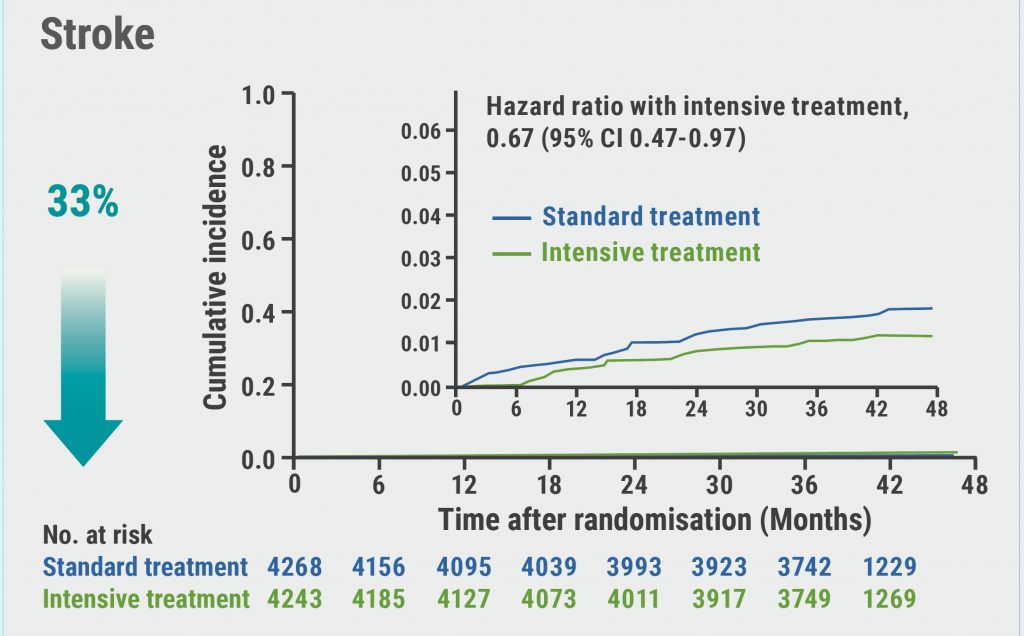Many factors impede BP control: most patients need at least 2 medications, treatment inertia is common, and patients have concerns regarding adverse events. Prof. Clara Chow (University of Sydney, Australia) pointed to a previous pilot study of her team that suggested that simplified strategies using low-dose, single-pill combinations might be a way to overcome barriers to BP control. In this study including 55 patients, a single pill with a quarter dose was more effective than monotherapy with a usual dose [3]. “This study was the rationale to perform the double-blind, randomised controlled QUARTET (ANZCTR 12616001144404) study,” Prof. Chow explained.
The primary objective of QUARTET was to determine whether hypertension management starting with a single pill containing quarter-standard doses of 4 types of BP lowering medicines (‘quadpill’) is more effective than an approach that starts with standard-dose monotherapy. The quadpill used contained a quarter dose of irbesartan, amlodipine, indapamide, and bisoprolol. Included patients were either untreated or received a monotherapy. They were randomised to initial quadpill (n=300) or monotherapy with irbesartan (n=291). Patients who failed to achieve the BP goal on their assigned therapy were treated with additional medication.
Extended cohorts were assessed after 52 weeks. “The majority (84%) was on the quadpill alone after 12 weeks. At 52 weeks, 79% were on the quadpill alone compared with 57% in the control arm,” Prof. Chow said. Up-titration occurred in 15% of the intervention group and 40% of control by 12 weeks.
After 12 weeks, the primary outcome of unattended office BP was lower in the initial quadpill group by 6.9 mmHg (95% CI 4.9–8.9; P<0.001) compared with patients receiving irbesartan monotherapy in the intention-to-treat analysis (P<0.0001). BP control was achieved by 76% of patients taking the quadpill versus 58% in the control group (BP<140/90 mmHg; RR 1.3; 95% CI 1.2–1.5; P<0.0001)
The quadpill remained superior until the end of the trial after 1 year. In the subgroup of 417 patients who stayed in the study for 52 weeks, patients taking the quadpill had a 7.7 mmHg lower systolic BP compared with the controls (95% CI 5.2–10.3 mmHg; P<0.0001), and 81% of patients taking the quadpill compared with 62% in the control group achieved BP control.
At 12 weeks, there were 7 (3%) versus 3 (1%) severe adverse events in the intervention versus control group. In addition, there were no excess adverse event-related treatment withdrawals (4.0% vs 2.4%, P=0.27).
“Starting on ultra-low-dose combination is more effective than the usual way of starting patients on 1 medication first. We were excited that we got patients to BP control so quickly,” Prof. Chow concluded.
- Chow CK. The effectiveness and tolerability of ultra-low-dose quadruple combination in treatment of hypertension – A multicentre double-blind randomised trial. Late-breaking science in hypertension, ESC Congress 2021, 27–30 August.
- Chow CK. Lancet;28 Aug. DOI:1016/S0140-6736(21)01922-X.
- Chow CK, et al. Lancet 2017;389:1035–42.
Copyright ©2021 Medicom Medical Publishers
Posted on
Previous Article
« Salt substitutes: a successful strategy to improve blood pressure Next Article
Smartphone app improves BP control independent of age, sex, and BMI »
« Salt substitutes: a successful strategy to improve blood pressure Next Article
Smartphone app improves BP control independent of age, sex, and BMI »
Table of Contents: ESC 2021
Featured articles
2021 ESC Clinical Practice Guidelines
2021 ESC Guidelines on Heart Failure
2021 ESC/EACTS Guidelines on Valvular Heart Disease
2021 ESC Guidelines on Cardiac Pacing and Cardiac Resynchronisation Therapy
2021 ESC Guidelines on Cardiovascular Disease Prevention
Best of the Hotline Sessions
Empagliflozin: First drug with clear benefit in HFpEF patients
CardioMEMS: neutral outcome but possible benefit prior to COVID-19
Cardiac arrest without ST-elevation: instant angiogram does not improve mortality
Older hypertensive patients benefit from intensive blood pressure control
Antagonising the mineralocorticoid receptor beneficial for patients with diabetes and CKD
Late-Breaking Science in Heart Failure
Valsartan seems to attenuate hypertrophic cardiomyopathy progression
Dapagliflozin reduces incidence of sudden death in HFrEF patients
Late-Breaking Science in Hypertension
Smartphone app improves BP control independent of age, sex, and BMI
QUARTET demonstrates that simplicity is key in BP control
Salt substitutes: a successful strategy to improve blood pressure
Late-Breaking Science in Prevention
NATURE-PCSK9: Vaccine-like strategy successful in lowering CV events
Polypill: A successful tool in primary prevention
Important Results in Special Populations
VOYAGER PAD: Fragile or diabetic patients also benefit from rivaroxaban
COVID-19 and the Heart
Rivaroxaban improves clinical outcomes in discharged COVID-19 patients
COVID-19: Thromboembolic risk reduction with therapeutic heparin dosing
Long COVID symptoms – Is ongoing cardiac damage the culprit?
ESC Spotlight of the Year 2021: Sudden Cardiac Death
Breathing problems: the most frequently reported symptom before cardiac arrest
Lay responders can improve survival in out-of-hospital cardiac arrest
Related Articles

October 26, 2021
2021 ESC/EACTS Guidelines on Valvular Heart Disease
October 26, 2021
Salt substitutes: a successful strategy to improve blood pressure
© 2024 Medicom Medical Publishers. All rights reserved. Terms and Conditions | Privacy Policy
HEAD OFFICE
Laarderhoogtweg 25
1101 EB Amsterdam
The Netherlands
T: +31 85 4012 560
E: publishers@medicom-publishers.com

